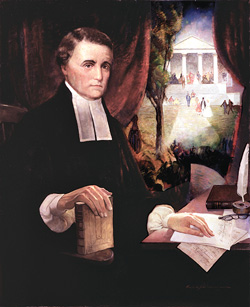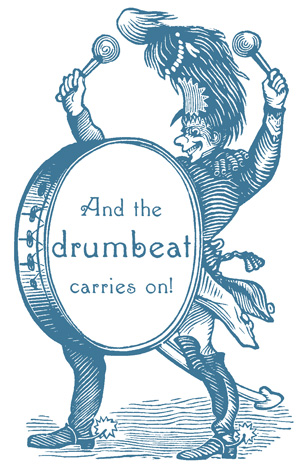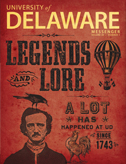275 Years of the University of Delaware
An abridged history by Jonathan Russ, historian and UD associate professor

When Francis Alison opened an academy in 1743, his first class was composed of 11 students, three of whom would go on to be at the forefront of the American Revolution and the founding of the Republic. Located in New London, Pennsylvania, it soon soon moved to Newark, Delaware, where it was chartered by the state as Newark College in 1833 and then as Delaware College a decade later. Celebrated as a leading school in the middle colonies (see below), it nevertheless struggled financially, and by the 1850s, the college was on the brink of shutting down entirely.
It was at this very juncture that the U.S. government enacted the Morrill Land Grant Act in 1862, which provided federal land to support agriculture and the mechanical arts and provided the means for the institution to not only stay afloat, but to prosper. It also helped bring new techniques to Delaware farmers through the Cooperative Extension Program.
At the time, the student body was slow to grow, and a growing chorus of voices called for the all-male institution to become coeducational. The Board of Trustees approved the admission of women to the college in 1872, but with few applicants, the plan was abandoned after a year. African American women, on the other hand, could attend the State College for Colored Students (now Delaware State University) since its founding in 1891.
However, things changed in 1914, with philanthropist Emalea Pusey Warner. Although not a college graduate herself, she was passionate about coeducation and had the financial and social ability to press her case. With additional pressure from parents wanting local educational options for their daughters, widespread support among the all-male student body and financial backing by the state Assembly, the Women’s College finally opened on Oct. 10, 1914. With only one dormitory and one building for instruction of the sciences, its impact upon the state was enormous. Whereas Delaware had ranked amongst the worst states in regard to the quality of its public schools in 1920, by the 1930s it had come to be ranked within the top 10. In large part this transformation occurred as a result of a challenging curriculum set by the College, and a coordinated effort to place these newly trained teachers in classrooms throughout the state.
Although Delaware College and the Women’s College academically were separate institutions that shared the same Board of Trustees, in 1921 they formally merged to become the University of Delaware. This was significant. Just as public school education was improving in the 1920s, so too were major scientific breakthroughs. Firms such as DuPont required chemists and engineers to advance their new product lines, and the University became a pipeline for such expertise.
Indeed, the newly combined University was a true innovator for its students. In 1923, for example, Pierre duPont underwrote a grant to Professor Raymond Kirkbride to lead the country’s first study abroad program. A World War I veteran and a professor of French literature, he persuaded Mr. duPont that immersion in a foreign culture was the best way for students to learn foreign language skills.
This is not to say, however, that the University was wholly progressive. Just as it had taken a long while to establish coeducation, the University remained an exclusively white institution until the mid-20th century. That changed when Louis Redding, the only black member of the Delaware Bar, represented eight African-American students who sued the University for the right to apply for admission. To be clear, they weren’t demanding to be admitted—just the right to apply. The case, Parker et al. v The University of Delaware, made the institution the first in the nation to desegregate by court order.
Coeducational and desegregated, the University’s next major challenge was the influx of the Baby Boomers, the millions of young adults born between 1946 and 1964 who were seeking higher education throuought the country. As if overnight, the campus suddenly needed new dormitory and classroom space. To meet its new needs, the University pursued a massive capital campaign, relying on private philanthropy to help fund a new era in UD history. New buildings arose, along with new residential areas including Harrington, Rodney, Dickinson and the North campus, including Pencader and the Christiana Towers. Further downstate, the University built an entire campus dedicated to marine studies. It was a massive undertaking, and one that would change the nature of the University forever.

Although the building boom of the 1960s and ‘70s plateaued by the 1980s, the early 21st century saw expansion once again. New dormitories were constructed, as were new facilities for the performing arts and engineering. Moreover, the acquisition of a 272-acre plot of land where a Chrysler factory had once operated marked the largest single-land purchase in the school’s history, growing the campus footprint by 22 percent and bolstering its commitment to Science, Technology and Advanced Research (STAR). It’s a significant new chapter in the University’s story, built upon core institutional strengths and intended to serve 21st century needs.
Despite an optimistic future, however, there are ongoing challenges for students and their families. The cost of education has long been a significant hurdle, but since its inception, the school has attempted to help students realize their academic dreams. Francis Alison allowed students to board in his home, and even during the grim financial days of the mid-19th century, the Board of Trustees granted as many scholarships as possible. More recently, the University established its Commitment to Delawareans, an academic roadmap to guarantee admission, along with a financial component to meet the full demonstrated needs of its state residents.
From a handful of local boys to over 20,000 students from around the world, the school has come a long way. And judging from the accomplishments of its alumni, faculty and students, it has been a journey well traveled.
For more on UD’s 275-year history, visit www.udel.edu/about/history/275



